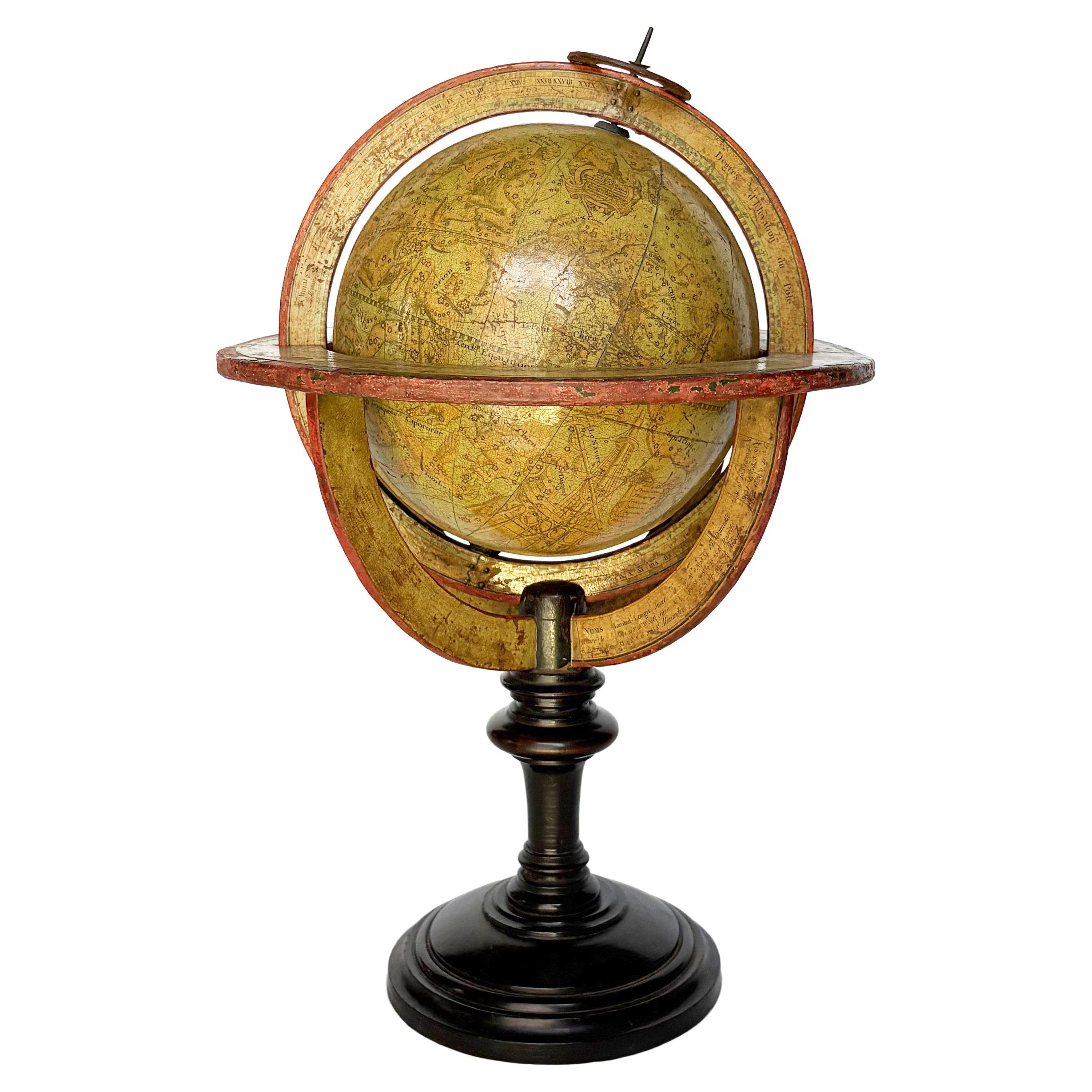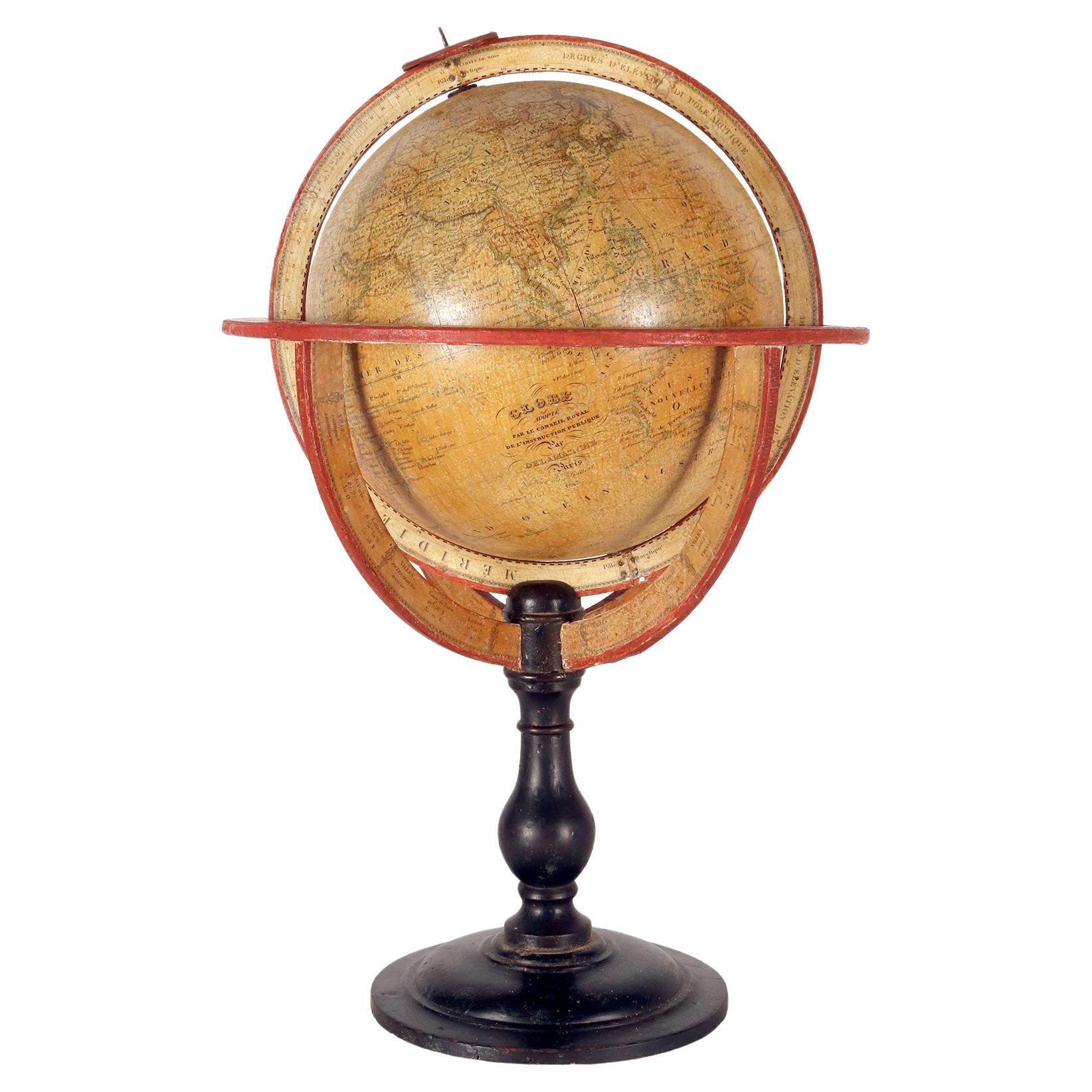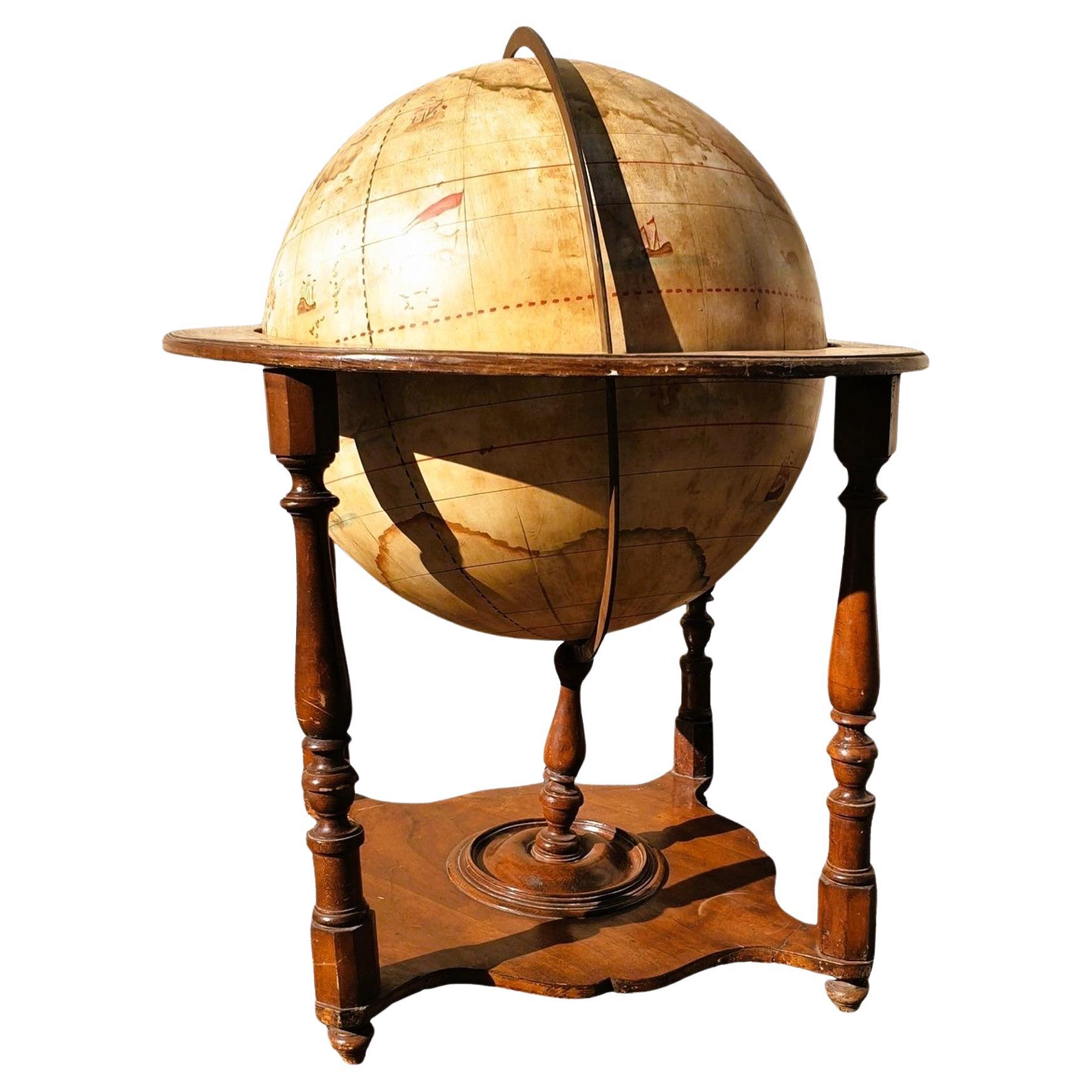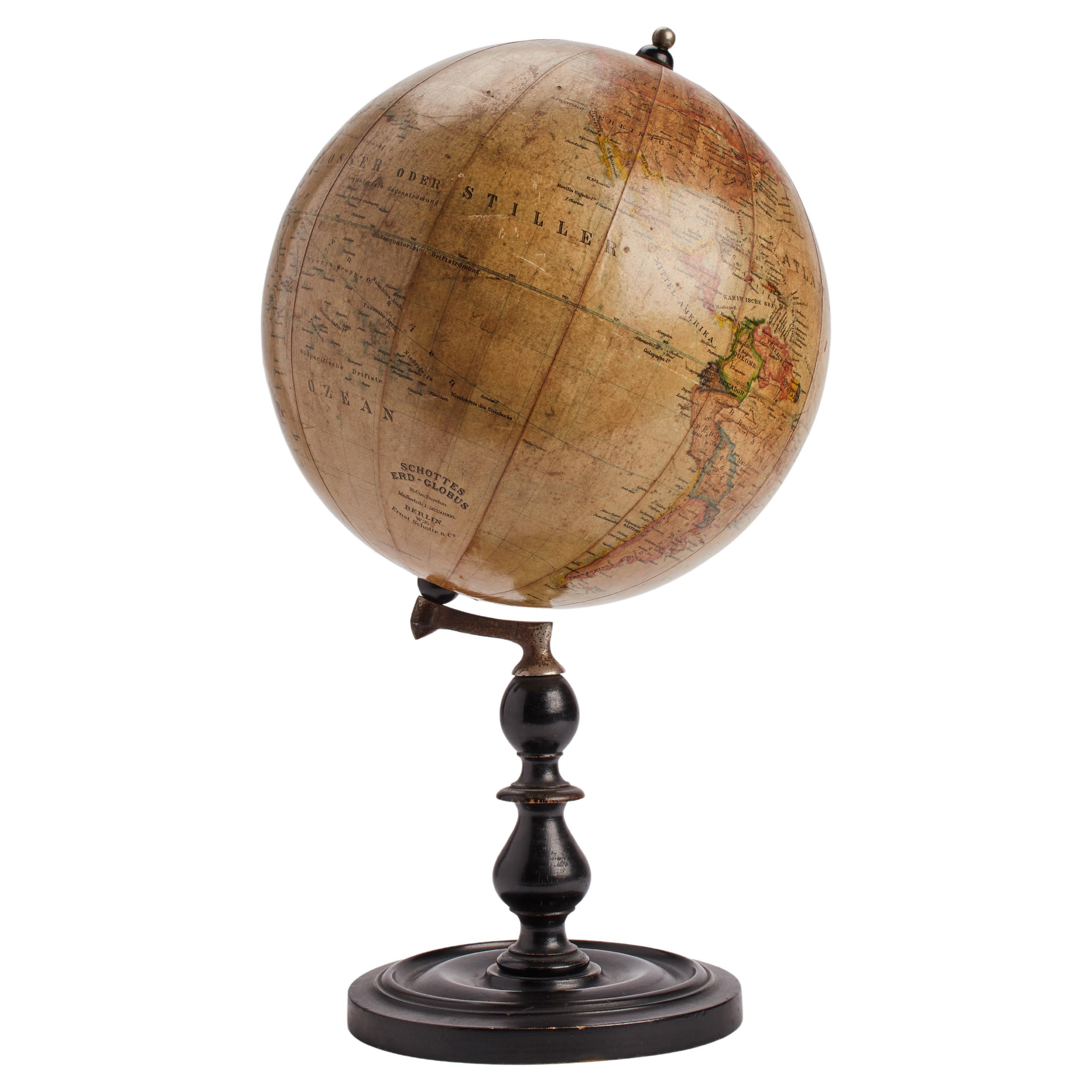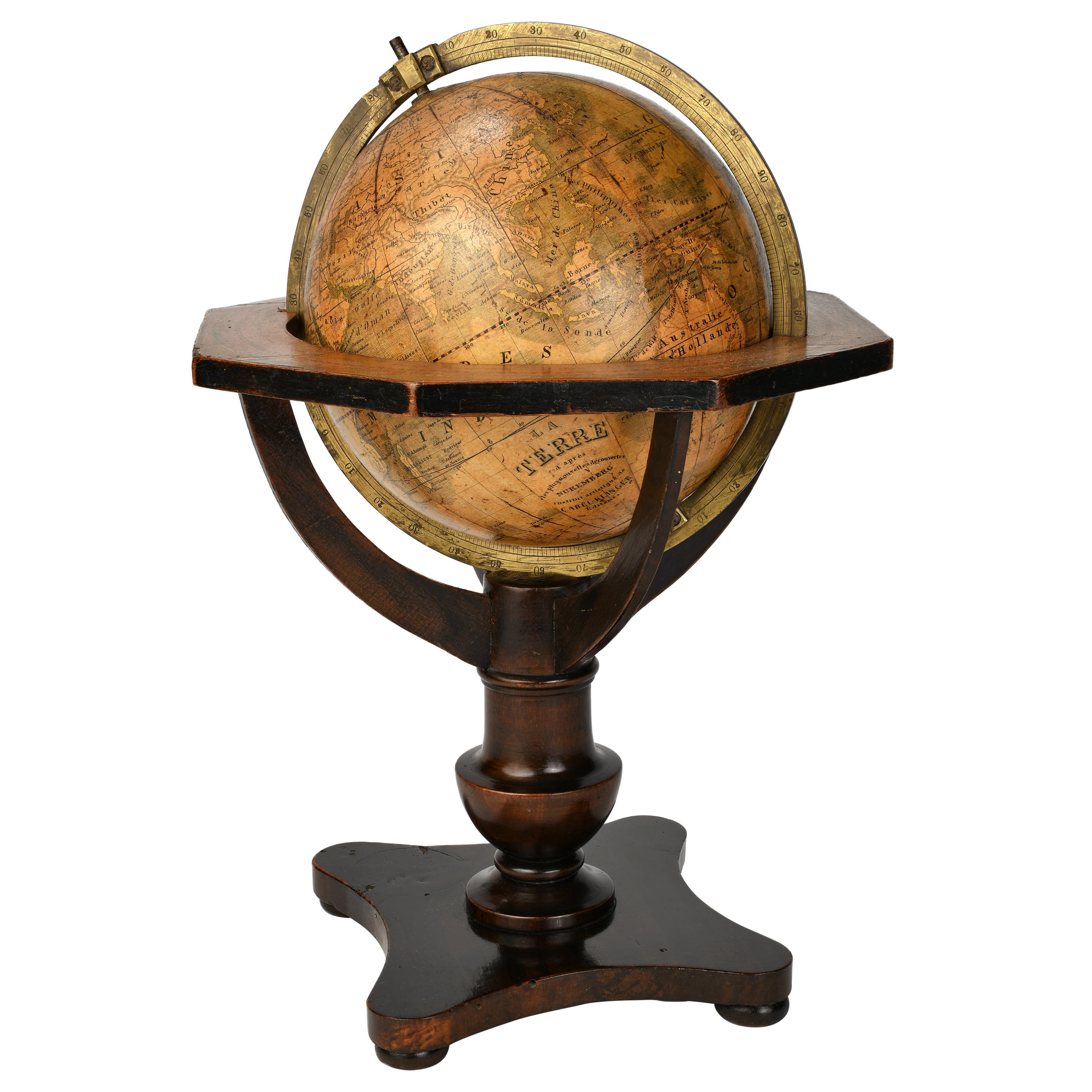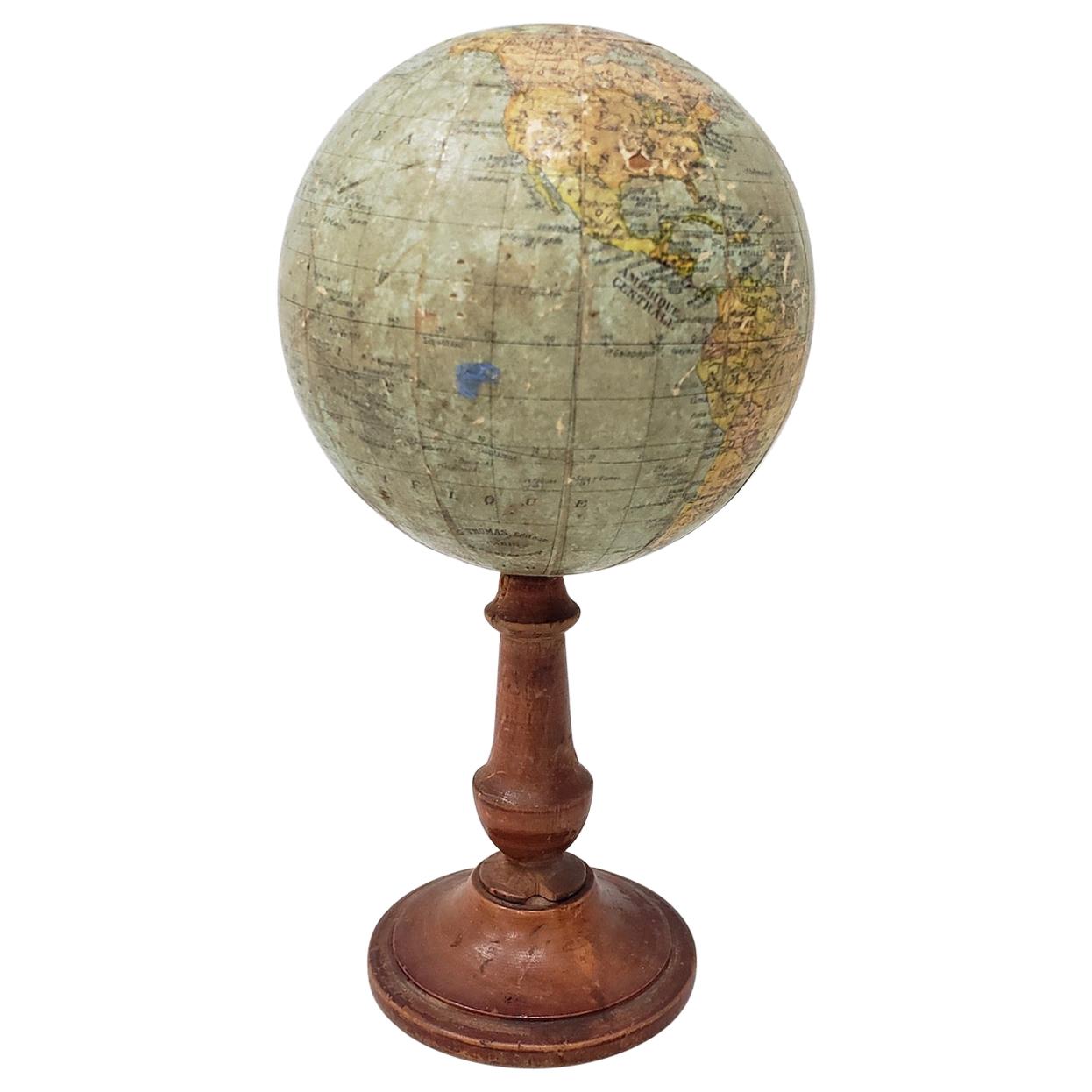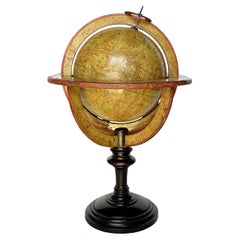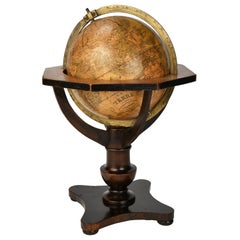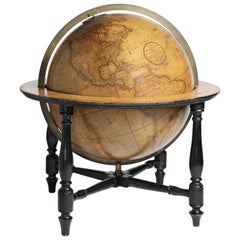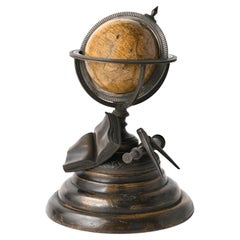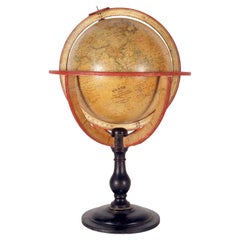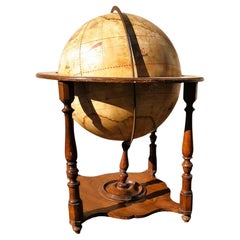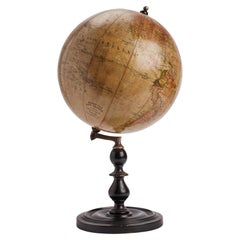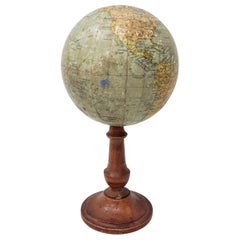Items Similar to Terrestrial Table Globe by Félix Delamarche, Paris, 1821
Video Loading
Want more images or videos?
Request additional images or videos from the seller
1 of 20
Terrestrial Table Globe by Félix Delamarche, Paris, 1821
$13,038.45
£9,764.05
€11,000
CA$18,247.53
A$20,006.97
CHF 10,447.49
MX$240,758.82
NOK 131,673.88
SEK 123,807.32
DKK 83,792.62
About the Item
Terrestrial table globe
Félix Delamarche
Paris, 1821
It measures 20.47 in height, Ø max 14.17 in; the sphere Ø 9.44 in (h 52 cm x Ø max 36.5 cm; the sphere Ø 24 cm)
Wood, printed, papier-mâché and metal
It rests on its original turned wood column base.
State of conservation: there are small gaps, abrasions and stains on the surface. In some places very slight swellings on the surface can be noticed. The small circle of the hours is from a later period.
The globe is composed of two series of twelve printed paper gores, aligned and glued onto a sphere made with a chalky-based dough.
The meridian circle and the horizon circle are made of wood, also covered with printed paper.
The first has the degrees of latitude and the distances from the poles inscribed.
The circle of the horizon, on the other hand, details the amplitude, the direction of the winds, the days and months of the year and the names and symbols of the zodiac.
There are two distinct cartouches on the sphere.
One is located in the southern Indian Ocean, between South Africa and Australia. It bears the inscription:
Revu et Corrigé
par F.x Delamarche
A PARIS
Chez Felix Delamarche et Charles Dien
Rue du Jardinet n°. 13
1821
The second one is found in the South Pacific Ocean, between New Zealand and South America. It bears the inscription:
Réduction du
GLOBE TERRESTRE
dressé par Ordre
DU ROI.
Par le S. Robert De Vaugondy
Géographe.
On the rest of the surface, continents and oceans appear with numerous geographical indications and references to the main explorations, especially those by Cook, but also by others, both contemporary and from previous eras.
A large part of central-eastern Africa is unexplored and, in the area of the great lakes, only a part of the Malawi basin is sketched in. The "Enderby Land" discovered by Biscoe in 1831 on the coast of Antarctica, south of Africa, is not marked.
The North American coasts are well outlined, but Alaska is not described and is only partially traced; it would become part of the United States in 1867.
Various islands in the Pacific and Indian Oceans are indicated.
Australia (name definitively used since 1824) is still called "Nouvelle Hollande", while Tasmania is already represented as an island; it was circumnavigated by Matthew Flinders in 1798.
Charles-François Delamarche (1740-1817) founded his laboratory around 1770 and, in a few years, he became the most famous French cartographer and globe maker between the 18th and 19th centuries. After having acquired the laboratory of the late Didier Robert de Vaugondy (1723-1786; himself a renowned cartographer who continued the family business founded by his grandfather Nicolas Sanson in the seventeenth century) and after having purchased, between 1788 and around 1800, the businesses of Jean-Baptiste Fortin (1750-1831) and Jean Lattré (around 1750-1800), he began to call himself "Successeur de MM. Sanson and Robert de Vaugondi, Géographes du Roi and de M. Fortin, Ingénieur-mécanicien du Roi pour les globes et les sphères".
Thus, at the end of the eighteenth century, Delamarche possessed the warehouse stocks, as well as the manufacturing skills of the globes of his main rivals in Paris.
In addition to this aggressive acquisition policy, the key to his success also lay in the combination of high-quality cartography combined with extremely attractive globes and armillary spheres; and, of course, its famous red paint finishing touch.
His laboratory was located in Rue de Foin St Jacques "au Collège Me. (or "Mtre") Gervais" in the Latin Quarter of Paris until around 1805, when he moved to rue du Jardinet n. 13.
On the death of Charles-François in 1817, the reins of the company passed to his son Félix (1779-1835), who continued to publish, often in collaboration with the engraver Charles Dien, Senior. In 1835 the company first moved to rue du Jardinet n. 12 and a little later to rue du Battoir n. 7.
Bibliography:
- Van der Krogt P., Old Globes in the Netherlands, Utrecht 1984, pp. 98-99;
- Van der Krogt P. e Dekker E., Globes from the Western World, London 1993, p. 78;
- Dekker E., et al., Globes at Greenwich: A Catalogue of the Globes and Armillary Spheres in the National Maritime Museum, Greenwich, London, 1999, pp. 321-322 for the story of the Delamarche family.
- Dekker E., Catalogue of Orbs, Spheres and Globes, Firenze-Milano 2004. The globes and spheres kept in the Museo Galileo in Florence are listed and described; pp. 164-166 n. 51-52 (inv. n. 3705 e n. 3369) a pair of globes, the terrestrial and the celestial, by Félix Delamarche larger than ours, but with the same year, 1821, of publication.
- Creator:Félix Delamarche (Maker)
- Dimensions:Height: 20.48 in (52 cm)Width: 14.38 in (36.5 cm)Depth: 14.38 in (36.5 cm)
- Style:Restauration (Of the Period)
- Materials and Techniques:
- Place of Origin:
- Period:
- Date of Manufacture:1821
- Condition:Wear consistent with age and use. There are small gaps, abrasions and stains on the surface. In some places very slight swellings on the surface can be noticed. The small circle of the hours is from a later period.
- Seller Location:Milano, IT
- Reference Number:1stDibs: LU4352233625962
About the Seller
4.3
Vetted Professional Seller
Every seller passes strict standards for authenticity and reliability
Established in 1860
1stDibs seller since 2018
21 sales on 1stDibs
Associations
International Confederation of Art and Antique Dealers' Associations
- ShippingRetrieving quote...Shipping from: Milano, Italy
- Return Policy
Authenticity Guarantee
In the unlikely event there’s an issue with an item’s authenticity, contact us within 1 year for a full refund. DetailsMoney-Back Guarantee
If your item is not as described, is damaged in transit, or does not arrive, contact us within 7 days for a full refund. Details24-Hour Cancellation
You have a 24-hour grace period in which to reconsider your purchase, with no questions asked.Vetted Professional Sellers
Our world-class sellers must adhere to strict standards for service and quality, maintaining the integrity of our listings.Price-Match Guarantee
If you find that a seller listed the same item for a lower price elsewhere, we’ll match it.Trusted Global Delivery
Our best-in-class carrier network provides specialized shipping options worldwide, including custom delivery.More From This Seller
View AllCelestial Table Globe, Charles-François Delamarche, Paris, 1791
By Charles Francois Delamarche
Located in Milano, IT
Celestial table globe
Charles-François Delamarche
Paris, 1791
It measures: 17.13 in in height, Ø max 27.7 in; the sphere Ø 7.09 in
(h 43.5 cm x Ø max 27.7 cm; the sphere Ø 18 cm).
W...
Category
Antique 1790s French Other Scientific Instruments
Materials
Metal
German Globe by C. Abel-Klinger, Nuremberg, circa 1860
By C. Abel-Klinger
Located in Milano, IT
Terrestrial globe
Artistic company C. Abel - Klinger
Nuremberg, circa 1860
H cm 31 x 22 cm (12.20 x 8.66 in); sphere 14 cm (5.51 in) in diameter
lb 2.30 (kg 1.04)
State of conservation: good. On the sphere there are slight visible signs of accidental bumping at the poles, as well as on New Guinea and England (vertical and more visible); some ink stains, especially at the South Pole and on the meridian that crosses North America.
The globe is composed of twelve whole gores of printed paper, juxtaposed and glued on a sphere made with a chalky base mixture.
The circle of the meridian, made of brass...
Category
Antique 1860s German Other Scientific Instruments
Materials
Wood, Paper
18-inch Globe, Cary's, London, 1840
By Cary’s
Located in Milano, IT
John and William Cary
Updated by George and John Cary
Terrestrial Globe
London, 1840
lb 22 (kg 10)
Slight surface abrasions due to use. A small crack on the horizon circle.
The globe rests in its original Dutch style stand with four supporting turned wood columns.
It measures 26 in in height x 23.6 in in diameter with the diameter of the sphere measuring 18 in; 66 cm in height x 60 cm in diameter with the diameter of the sphere measuring 45.72 cm.
The 18 inch...
Category
Antique 1840s English Early Victorian Globes
Materials
Paper, Wood
Miniature Terrestrial Globe Newton & Son London, Post 1833, Ante 1858
By Newton and Son
Located in Milano, IT
Miniature Terrestrial Globe
Newton & Son
London, post 1833, ante 1858
Paper, papier-mâché, bronze and wood
It measures: sphere diameter 2.95 in (7.6 cm); diameter of the wooden base 6.02 in (15.3 cm); height 8.36 in (21.24 cm).
Weight: 2,067 lb.
State of conservation: the globe still bears its original paint, but has various small gaps, abrasions and stains on the surface.
The globe is hinged with two pins at the meridian circle, which is in turn inserted perpendicular to the horizon circle; this is supported by four semi-arches connected at the bottom by a small goblet-shaped foot, resting on a wooden bell-shaped base.
Apart from the wooden base, the entire support structure is made of bronze; on the foot there are the scale reproductions of a compass, a telescope and an open book.
The sphere is made of papier-mâché and is covered with twelve printed paper gores.
In the North Pacific Ocean the globe bears a cartouche with the inscription (about 30% of the writing is illegible, but the missing parts can be easily integrated based on the rest):
NEWTON’S
New & Improved
TERRESTRIAL
Globe
Published by Newton & Son
66 Chancery Lane
LONDON
On the globe, much of central Africa is empty and the great lakes Tanganyika and Victoria are not marked (Europeans would begin to explore the area after 1858). Canada is called "British Territory" and Alaska "Russian Territory" (it would become part of the United States in 1867). Australia already bears its modern name (until 1829 it had been called New Holland) and its coasts are completely designed; Tasmania is listed as an island (Matthew Flinders circumnavigated it in 1798). The routes of Cook's various voyages are plotted; both the route followed by Biscoe in 1831 and the "Land of Enderby" which he discovered on the coast of Antarctica, south of Africa, are marked.
Bibliography
P. Van der Krogt, Old Globes...
Category
Antique 1840s English Early Victorian Maps
Materials
Bronze
Ptolemaic Armillary Sphere, Charles-François Delamarche, Paris, ante 1798
By Charles Francois Delamarche
Located in Milano, IT
Ptolemaic armillary sphere
Charles-François Delamarche
Paris, ante 1798
Wood and papier-mâché
covered with printed and partly hand-colored paper
It measures 15.55 in in height x Ø 10...
Category
Antique 1790s French Other Scientific Instruments
Materials
Wood, Paper
Ptolemaic Armillary Sphere, Charles-François Delamarche, Paris, ante 1798
By Charles Francois Delamarche
Located in Milano, IT
Ptolemaic armillary sphere
Charles-François Delamarche
Paris, ante 1798
Wood and papier-mâché
covered with printed and partly hand-colored paper
It measures 16.37 in in height x Ø 10.94 in (41.60 cm - Ø 27.80 cm)
It weights 2.33 lb (1,058 g)
State of conservation: consistent with its age and use, the paper shows some signs of use, stains and abrasions.
The sphere is Ptolemaic, with the Earth placed at its center, surrounded by the Moon and the Sun mounted on two metal arms.
The sphere is composed of six horizontal and two vertical rings (armillae), each bearing graduations and its own name.
The first horizontal ring is illegible. The others, in descending order are: North Pole, Tropic of Cancer, Equator, Tropic of Capricorn, South Pole.
The vertical rings consist of two double meridians.
The sphere is then connected to the large meridian by two pins, a vertical ring inserted perpendicularly into the circle of the Horizon, in turn supported by four semicircles connected to the turned and black-stained wooden base.
Each element is covered with printed paper. It contains various pieces of information: latitudes, length of days, names and zodiac symbols, calendar, wind directions, etc.
The vertical circles mention the latitudes and longitudes of different cities: Rome, Bordeaux, Madrid, Boston, Batavia (Jakarta), Acapulco, etc.
Even the small terrestrial globe is covered with printed paper: continents and oceans appear with numerous geographical markings indicating the most recent explorations.
In the Pacific Ocean, west of South America bears the following inscription:
GLOBE
TERRESTRIAL
à Paris
chez Delamarche Géog
Rue du Foin Jacques
Au Collège de
M.e Gervais
The North American coasts are well delineated and California appears correctly as a peninsula - reports from Spanish explorers in the region had given rise to confusion as to whether it was connected to the mainland or not. The geographical nature of California was confirmed after the explorations of Juan Bautista de Anza (1774-1776).
Alaska is not described and is only partially traced; it would become part of the United States in 1867.
Various Pacific islands are indicated.
Australia (the name definitely used from 1824) is called "Nouvelle Hollande."
Tasmania is still represented as a peninsula and this is an important detail for the dating of our armillary sphere.
The island is separated from Australia by Bass Strait, which was crossed by Matthew Flinders for the first time in 1798, showing that it was not a peninsula. Delamarche certainly would not have waited a long time to update such an important geographical datum: presumably he did so shortly after receiving the news.
Charles-François Delamarche (1740-1817) founded his laboratory around 1770 and, in a few years, he became the most famous French cartographer and globe maker between the 18th and 19th centuries. After having acquired the laboratory of the late Didier Robert de Vaugondy (1723-1786; himself a renowned cartographer who continued the family business founded by his grandfather Nicolas Sanson in the seventeenth century) and after having purchased, between 1788 and around 1800, the businesses of Jean-Baptiste Fortin (1750-1831) and Jean Lattré (around 1750-1800), he began to call himself "Successeur de MM. Sanson and Robert de Vaugondi, Géographes du Roi and de M. Fortin, Ingénieur-mécanicien du Roi pour les globes et les sphères."
Thus, at the end of the eighteenth century, Delamarche possessed the warehouse stocks, as well as the manufacturing skills of the globes of his main rivals in Paris.
In addition to this aggressive acquisition policy, the key to its success also lay in the combination of high-quality cartography combined with extremely attractive globes and armillary spheres; and, of course, its famous red paint finishing touch.
His laboratory was located on Rue de Foin St Jacques "au Collège Me. (or "Mtre") Gervais" in the Latin Quarter of Paris until around 1805, when he moved to rue du Jardinet No. 13.
On the death of Charles-François in 1817, the reins of the company passed to his son Félix (1779-1835), who continued to publish, often in collaboration with the engraver Charles Dien, Sr. In 1835 the company first moved to rue du Jardinet No. 12 and a little later to rue du Battoir No. 7.
Bibliography:
Dekker, Elly, et al. Globes at Greenwich...
Category
Antique 1790s French Other Scientific Instruments
Materials
Wood, Paper
You May Also Like
A terrestrial seven inches globe, signed Felix Delamache, France 1845.
By Félix Delamarche
Located in Milan, IT
Engraved wooden and paper maché globe. Equator resting on four quarter meridians on a turned black fruit wooden base with moved profile and circular base.
The globe is composed of tw...
Category
Antique 1840s Italian Scientific Instruments
Materials
Wood, Paper
Library Terrestrial Globe On Stand, Late 19th Early 20th Century
Located in MARSEILLE, FR
Large terrestrial globe in papier maché and plaster, fixed in its wooden basket: the spindles are painted with the continents (decoratively), the complete meridian is in brass; the h...
Category
Antique Late 19th Century Italian Renaissance Scientific Instruments
Materials
Wood, Paper
Terrestrial globe published by Ernst Schotte & co, Germany 1890.
Located in Milan, IT
Terrestrial globe in watercolored paper, fixed with an inclined axis through a small brass arm, mounted on a black turned fruit wood base. Published by Ernst Schotte & Co. Berlin, Ge...
Category
Antique Late 19th Century German Scientific Instruments
Materials
Brass
19th Century Terrestrial Globe by G. Thomas, Editeur & Globe Maker, Paris, 1890s
By G. Thomas, Éditeur
Located in San Francisco, CA
Rare 19th century terrestrial globe by G. Thomas, Editeur & Globe Maker, Paris, circa 1890s
The globe sits atop a wooden stand and measures 4" diameter x 6.5" high.
The globe i...
Category
Antique Late 19th Century French Globes
Materials
Paper
19th Century Terrestrial Globe - by Ikelmer Paris
By Ikelmer
Located in Casteren, Noord-Brabant
A beautiful antique globe, issued by the French maker Ikelmer Paris.
The globe was made around 1880-1890.
The globe is made of paper, the base is made of black lacquered wood.
The gl...
Category
Antique Late 19th Century French Belle Époque Globes
Materials
Wood, Paper
Large terrestrial globe by Joseph Forest, Paris, France, circa 1890
Located in Paris, FR
Large swiveling globe in plastered cardboard covered with printed paper.
The meridian, attached to each pole, is in engraved brass. The base is in blackened turned wood.
The colors a...
Category
Antique 1890s French Desk Sets
Materials
Brass
More Ways To Browse
Terrestrial Globes
Turned Wood Columns
French Terrestrial Globe
Armillary Globe
Antique Cameras Folding Cameras
Antique Hanging Scale
Antique Pomanders
Antique Standing Scale
Antique Wall Thermometer
Antique Weather Stations
Antique Wood Plane
Art Deco Camera
Didactic Model
French Binoculars
German Barometer
Retro Weather Station
Antique French Opera Glasses
Antique Reading Glasses
